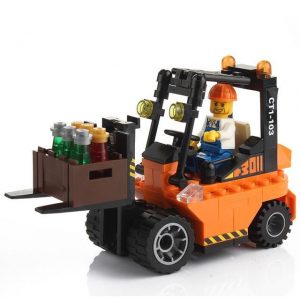 If you don’t use them properly, they can kill and injure people. Follow this advice to help you and those you work with stay safe.
If you don’t use them properly, they can kill and injure people. Follow this advice to help you and those you work with stay safe.
Operating
Always:
■ carry out a pre-shift check of the lift truck;
■ wear operator restraints, where fitted;
■ look all around before moving off;
■ look in the direction of travel;
■ travel at a speed suitable for the location and the load you are carrying;
■ travel with the forks lowered, but clear of the ground;
■ watch out for pedestrians;
■ watch out for obstructions;
■ avoid sudden stops and violent braking;
■ slow down at corners, doorways, and at every danger spot and sound the horn where necessary;
■ apply the parking brake when leaving the lift truck;
■ face the lift truck and use steps and handholds when getting in or out.
Never:
■ operate a lift truck unless you are trained and authorised to do so;
■ use a lift truck or equipment you know is not working properly;
■ operate controls from outside the cab, unless it is designed so you can do this;
■ stand on or near the controls to reach the load or anything outside the cab;
■ travel on uneven ground unless the lift truck is suitable for this;
■ run over unprotected cables or flexible pipes;
■ try to carry out repairs – leave this to a qualified maintenance engineer;
■ operate a lift truck when under the influence of alcohol or drugs;
■ use mobile phones or other hand-held devices while operating or travelling.
Loads
Always:
■ observe floor loading limits – find out the weight of the laden lift truck;
■ ensure there is adequate clearance for the lift truck and load, including overhead;
■ lower loads at a safe speed;
■ use suitable attachments for lifting unusual or wide loads and follow the manufacturer’s instructions;
■ ensure you are properly trained, competent and authorised to operate the lift truck with the attachment being used.
Never:
■ lift loads greater than the capacity of the lift truck;
■ move a load that appears unsuitable or unstable (including on a damaged pallet);
■ travel with a bulky load which blocks your view;
■ travel with a raised load, unless the lift truck is designed for this;
■ use an attachment unless a competent person, an authorised dealer or manufacturer has derated the lift truck (reduced the actual capacity).
Slopes
Always:
■ travel slowly when going down slopes;
■ when carrying a load, ensure the forks face uphill when travelling up or down slopes;
■ without a load, ensure the forks face downhill when travelling up or down slopes;
■ adjust the tilt (where fitted) to suit the gradient and raise the forks to clear the ground.
Never:
■ attempt to turn on or travel across a ramp or a slope;
■ leave a lift truck on a gradient except in an emergency, in which case always chock the wheels.
People
Always:
■ use a safe work method when using working platforms.
Never:
■ lift a person on the forks, or on a pallet, or similar, balanced on the forks;
■ carry passengers, unless the lift truck is designed for this;
■ allow people to walk under raised forks or loads;
■ pick up a load if someone is standing close to it.
When you have finished working
Always:
■ park the lift truck on level ground, never on a slope;
■ leave the lift truck with the mast tilted forwards and the forks fully lowered, with the tips on the floor;
■ apply the parking brake, select neutral, switch off the engine and remove the key;
■ return keys or other activating devices to their place of safe-keeping.
Contact us if you require further information.
Join the blog page for further information – click here.